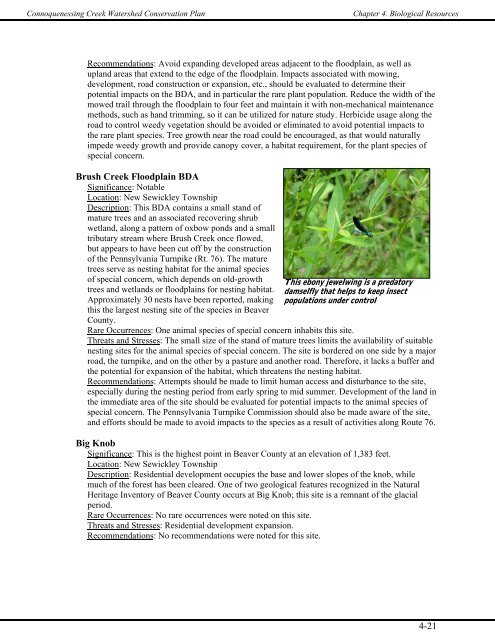CHAPTER 4 - Western Pennsylvania Conservancy
CHAPTER 4 - Western Pennsylvania Conservancy
CHAPTER 4 - Western Pennsylvania Conservancy
Create successful ePaper yourself
Turn your PDF publications into a flip-book with our unique Google optimized e-Paper software.
Connoquenessing Creek Watershed Conservation Plan<br />
Chapter 4. Biological Resources<br />
Recommendations: Avoid expanding developed areas adjacent to the floodplain, as well as<br />
upland areas that extend to the edge of the floodplain. Impacts associated with mowing,<br />
development, road construction or expansion, etc., should be evaluated to determine their<br />
potential impacts on the BDA, and in particular the rare plant population. Reduce the width of the<br />
mowed trail through the floodplain to four feet and maintain it with non-mechanical maintenance<br />
methods, such as hand trimming, so it can be utilized for nature study. Herbicide usage along the<br />
road to control weedy vegetation should be avoided or eliminated to avoid potential impacts to<br />
the rare plant species. Tree growth near the road could be encouraged, as that would naturally<br />
impede weedy growth and provide canopy cover, a habitat requirement, for the plant species of<br />
special concern.<br />
Brush Creek Floodplain BDA<br />
Significance: Notable<br />
Location: New Sewickley Township<br />
Description: This BDA contains a small stand of<br />
mature trees and an associated recovering shrub<br />
wetland, along a pattern of oxbow ponds and a small<br />
tributary stream where Brush Creek once flowed,<br />
but appears to have been cut off by the construction<br />
of the <strong>Pennsylvania</strong> Turnpike (Rt. 76). The mature<br />
trees serve as nesting habitat for the animal species<br />
of special concern, which depends on old-growth<br />
trees and wetlands or floodplains for nesting habitat.<br />
Approximately 30 nests have been reported, making<br />
this the largest nesting site of the species in Beaver<br />
County.<br />
Rare Occurrences: One animal species of special concern inhabits this site.<br />
This ebony jewelwing is a predatory<br />
damselfly that helps to keep insect<br />
populations under control<br />
Threats and Stresses: The small size of the stand of mature trees limits the availability of suitable<br />
nesting sites for the animal species of special concern. The site is bordered on one side by a major<br />
road, the turnpike, and on the other by a pasture and another road. Therefore, it lacks a buffer and<br />
the potential for expansion of the habitat, which threatens the nesting habitat.<br />
Recommendations: Attempts should be made to limit human access and disturbance to the site,<br />
especially during the nesting period from early spring to mid summer. Development of the land in<br />
the immediate area of the site should be evaluated for potential impacts to the animal species of<br />
special concern. The <strong>Pennsylvania</strong> Turnpike Commission should also be made aware of the site,<br />
and efforts should be made to avoid impacts to the species as a result of activities along Route 76.<br />
Big Knob<br />
Significance: This is the highest point in Beaver County at an elevation of 1,383 feet.<br />
Location: New Sewickley Township<br />
Description: Residential development occupies the base and lower slopes of the knob, while<br />
much of the forest has been cleared. One of two geological features recognized in the Natural<br />
Heritage Inventory of Beaver County occurs at Big Knob; this site is a remnant of the glacial<br />
period.<br />
Rare Occurrences: No rare occurrences were noted on this site.<br />
Threats and Stresses: Residential development expansion.<br />
Recommendations: No recommendations were noted for this site.<br />
4-21














